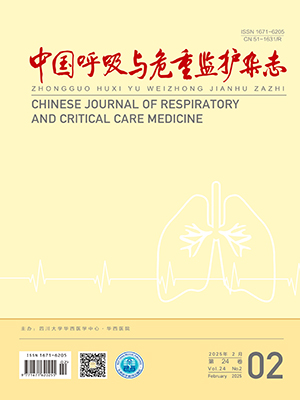| 1. |
Wilson NJ, Boniface K, Chan JR, et al. Development, cytokine profile and function of human interleukin 17-producing helper T cells. Nat Immunol, 2007, 8(9): 950-957.
|
| 2. |
Che KF, Tengvall S, Levanen B, et al. Interleukin-26 in antibacterial host defense of human lungs. Effects on neutrophil mobilization. Am J Respir Crit Care Med, 2014, 190(9): 1022-1031.
|
| 3. |
Bao A, Che KF, Bozinovski S, et al. Recombinant human IL-26 facilitates the innate immune response to endotoxin in the bronchoalveolar space of mice in vivo. PLoS One, 2017, 12(12): e0188909.
|
| 4. |
Cui SN, Chen L, Yang YY, et al. Activation of death-associated protein kinase 1 promotes neutrophil apoptosis to accelerate inflammatory resolution in acute respiratory distress syndrome. Lab Invest, 2019. [Epub ahead of print].
|
| 5. |
Wang CN, Lin YC, Chang BC, et al. Targeting the phosphorylation site of myristoylated alanine-rich C kinase substrate alleviates symptoms in a murine model of steroid-resistant asthma. Br J Pharmacol, 2019, 176(8): 1122-1134.
|
| 6. |
Fang H, Hua C, Weiss S, et al. Modulation of innate immunity by G-CSF and inflammatory response by LBPK95A improves the outcome of sepsis in a rat model. J Immunol Res, 2018: 6085095.
|
| 7. |
Denning NL, Yang WL, Hansen L, et al. C23, an oligopeptide derived from cold-inducible RNA-binding protein, suppresses inflammation and reduces lung injury in neonatal sepsis. J Pediatr Surg, 2019, pii: S0022-3468(18)30885-6.
|
| 8. |
Faller S, Hausler F, Goeft A, et al. Hydrogen sulfide limits neutrophil transmigration, inflammation, and oxidative burst in lipopolysaccharide-induced acute lung injury. Sci Rep, 2018, 8(1): 14676.
|
| 9. |
Santiago V, Rezvani K, Sekine T, et al. Human NK cells develop an exhaustion phenotype during polar degranulation at the Aspergillus fumigatus hyphal synapse. Front Immunol, 2018, 9: 2344.
|
| 10. |
Matute-Bello G, Downey G, Moo BB, et al. An official American Thoracic Society workshop report: features and measurements of experimental acute lung injury in animals. Am J Respir Crit Care Med, 2011, 44(5): 725-738.
|
| 11. |
Su YC, Jalalvand F, Thegerstrom J, et al. The interplay between immune response and bacterial infection in COPD: focus upon non-typeable Haemophilus influenzae. Front Immunol, 2018, 9: 2530.
|
| 12. |
Tillotson GS, Zinner SH. Burden of antimicrobial resistance in an era of decreasing susceptibility. Expert Rev Anti Infect Ther, 2017, 15(7): 663-676.
|
| 13. |
Jatzlauk G, Bartel S, Heine H, et al. Influences of environmental bacteria and their metabolites on allergies, asthma, and host microbiota. Allergy, 2017, 72(12): 1859-1867.
|
| 14. |
Tengvall S, Che KF, Lindén A, et al. Interleukin-26: an emerging player in host defense and inflammation. J Innate Immun, 2016, 8(1): 15-22.
|
| 15. |
Wu Y, Wang L, Meng L, et al. MIP-1α and NF-κB as indicators of acute kidney injury secondary to acute lung injury in mechanically ventilated patients. Eur Rev Med Pharmacol Sci, 2016, 20(18): 3830-3834.
|
| 16. |
Katsura H, Kobayashi Y, Tata PR, et al. IL-1 and TNFα contribute to the inflammatory niche to enhance alveolar regeneration. Stem Cell Reports, 2019, 12(4): 657-666.
|
| 17. |
Fei D, Meng X, Yu W, et al. Fibronectin (FN) cooperated with TLR2/TLR4 receptor to promote innate immune responses of macrophages via binding to integrin beta1. Virulence, 2018, 9(1): 1588-1600.
|
| 18. |
Akram A, Han B, Masoom H, et al. Activating transcription factor 3 confers protection against ventilator-induced lung injury. Am J Respir Crit Care Med, 2010, 182(4): 489-500.
|
| 19. |
Matsuki A, Takatori H, Makita S, et al. T-bet inhibits innate lymphoid cell-mediated eosinophilic airway inflammation by suppressing IL-9 production. J Allergy Clin Immunol, 2017, 139(4): 1355-1367. e6.
|
| 20. |
Miyamoto C, Kojo S, Yamashita M, et al. Author Correction: Runx/Cbfβ complexes protect group 2 innate lymphoid cells from exhausted-like hyporesponsiveness during allergic airway inflammation. Nat Commun, 2019, 10(1): 1075.
|
| 21. |
Monin L, Mehta S, Elsegeiny W, et al. Aspergillus fumigatus preexposure worsens pathology and improves control of Mycobacterium abscessus pulmonary infection in mice. Infect Immun, 2018, 86(3): pii: e00859-17.
|




